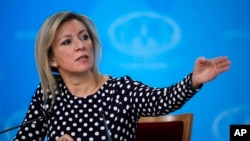“The protests in Yerevan and regions of the republic, judging from statements made by their participants, are caused by their discontent with what they see as a not quite fair delimitation [of the Armenian-Azerbaijani border,]” said Maria Zakharova, the Russian Foreign Ministry spokeswoman. “In any case, we regard political processes in Armenia as that country’s internal affair.”
Moscow remains intent on maintaining and deepening its traditionally close relations with “the people of Armenia,” she added during a news briefing.
On May 15, Zakharova accused the U.S. and European media of turning a blind eye to “mass detentions” of and the use of “brute” police fore against Armenian protesters demanding Pashinian’s resignation. This sharply contrasts with their critical coverage of security forces in neighboring Georgia using force against Western-backed demonstrators in Tbilisi, she said, underscoring Moscow’s deepening rift with Pashinian’s government.
Pashinian has alleged that foreign intelligence “agents” are involved in the protests against his territorial concessions to Baku. Some of his political allies have branded the protest leader, Archbishop Bagrat Galstanian, as a Russian spy. Galstanian and Armenian opposition leaders supporting him shrug off such allegations.
The land transfer is part of an Armenian-Azerbaijani border deal announced on April 19. Pashinian has portrayed it as the start of a delimitation of the long border between the two South Caucasus states. His domestic critics say he simply agreed to hand over territory to Azerbaijan without getting anything in return.
Zakharova said on Thursday that Moscow believes Armenian-Azerbaijani border disputes should be settled by “solely political and diplomatic methods” and yield “balanced and mutually acceptable” solutions.




